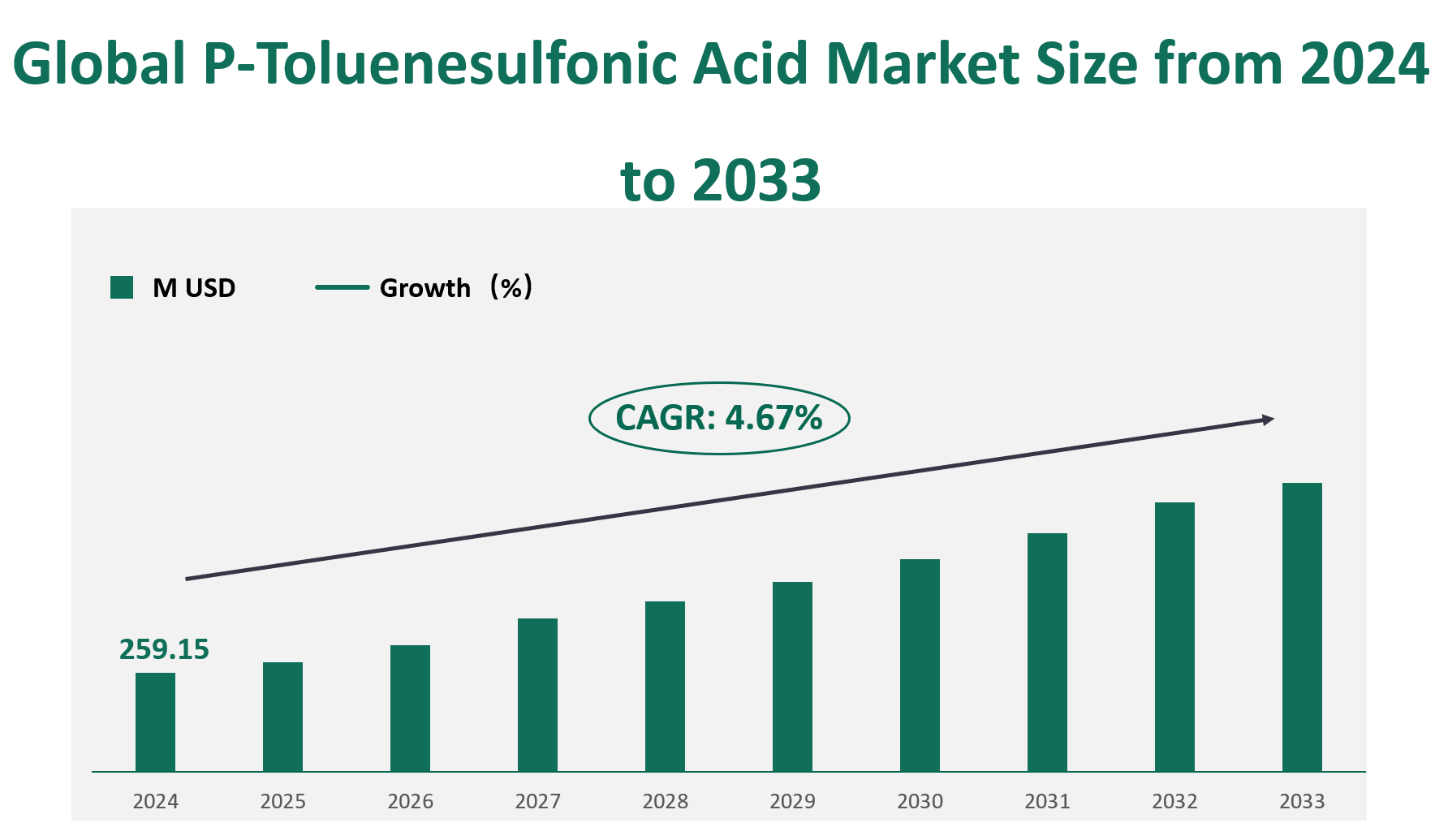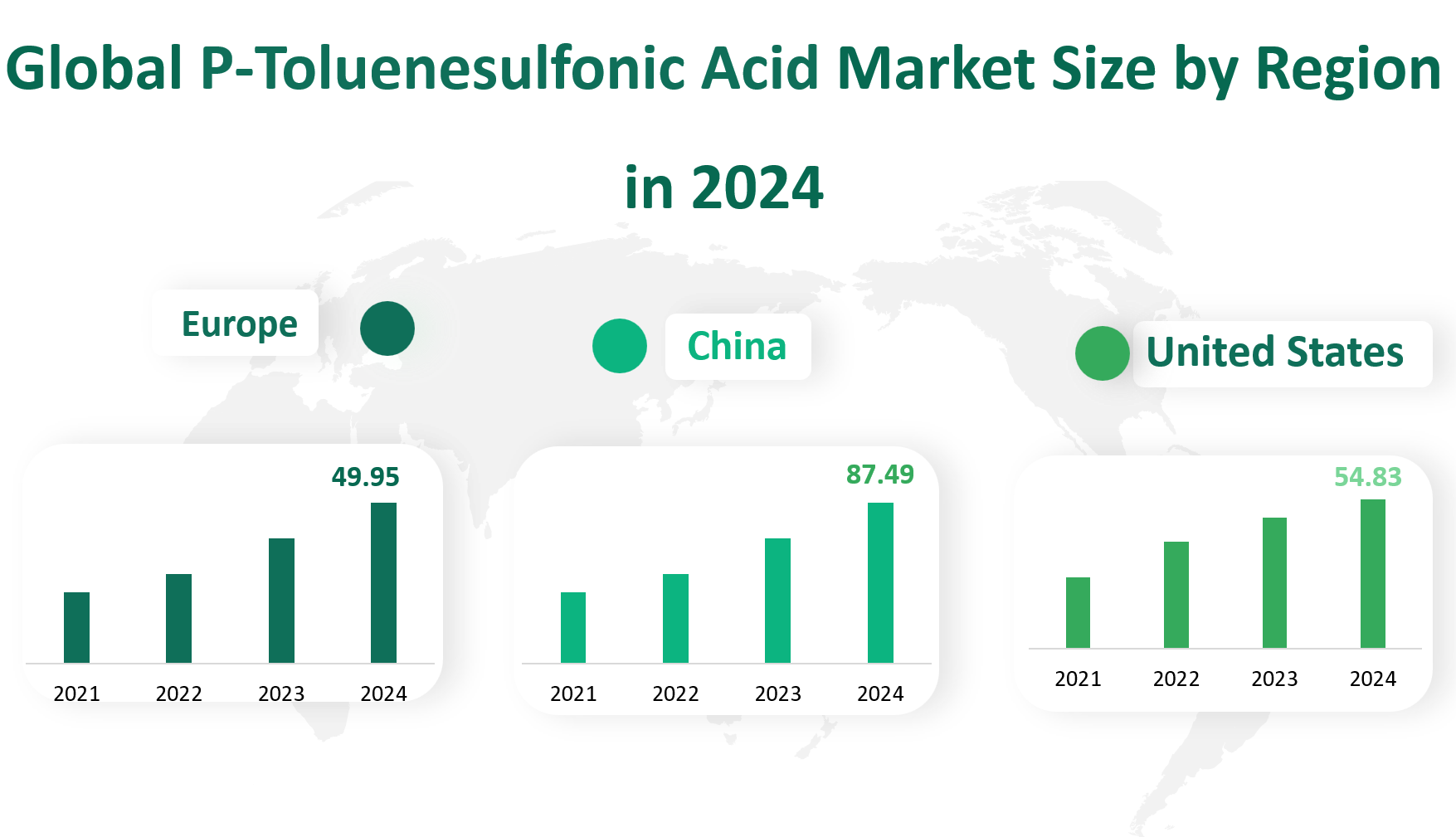1. Global P-Toluenesulfonic Acid Market Insight Analysis
In 2024, the global P-Toluenesulfonic Acid market revenue is projected to reach $259.15 million, with a Compound Annual Growth Rate (CAGR) of 4.67% from 2024 to 2033.
P-Toluenesulfonic Acid is a strong organic acid with a chemical formula of C7H8O3S. It is typically found in liquid or crystalline form and is widely used in the synthesis of pharmaceuticals, pesticides, and other chemicals. Its applications span across various industries due to its strong acidic properties and catalytic capabilities. For instance, it is used as a catalyst in the production of doxycycline, a widely-used antibiotic, and in the manufacturing of resins and coatings. The acid’s versatility and efficiency in chemical reactions make it an essential component in many industrial processes.
Figure Global P-Toluenesulfonic Acid Market Size (M USD) and CAGR (2024-2033)

2. Driving and Limiting Factors of P-Toluenesulfonic Acid Market Growth
The growth of the P-Toluenesulfonic Acid market is influenced by several key factors. On the positive side, the increasing demand for pharmaceuticals, driven by an aging global population and the need for more effective medications, is a significant driver. The acid is a critical intermediate in the production of various pharmaceutical compounds, particularly antibiotics and other essential drugs. Additionally, the growing need for environmentally friendly catalysts in chemical processes has boosted the market, as P-Toluenesulfonic Acid is considered a safer alternative to many traditional catalysts.
However, the market also faces several challenges. One of the primary limiting factors is the fluctuation in raw material prices, particularly for toluene and sulfuric acid, which are key components in the production of P-Toluenesulfonic Acid. Price volatility can significantly impact production costs and profitability. Additionally, the market is highly competitive, with several players vying for market share. This competition can lead to price wars and reduced profit margins, making it difficult for new entrants to establish a foothold.
3. Technology Innovation and Corporate Mergers and Acquisitions in P-Toluenesulfonic Acid Market
Technological innovation plays a crucial role in the P-Toluenesulfonic Acid market. Companies are continuously investing in research and development to improve production efficiency, reduce costs, and enhance product quality. For instance, advancements in catalytic processes and green chemistry are enabling more sustainable and cost-effective production methods. These innovations not only improve the environmental footprint of the industry but also open up new market opportunities.
Corporate mergers and acquisitions are another significant trend in the P-Toluenesulfonic Acid market. Larger companies are acquiring smaller firms to expand their product portfolios and strengthen their market positions. For example, Stepan, a leading player in the market, has made several strategic acquisitions to enhance its production capabilities and market reach. These mergers and acquisitions help companies achieve economies of scale, improve their technological capabilities, and better compete in the global market.
4. Global P-Toluenesulfonic Acid Market Size by Type
P-Toluenesulfonic Acid (PTSA) is a versatile chemical compound used across various industries due to its strong acidic properties and catalytic capabilities. The market for PTSA is segmented based on product purity, with three primary types: ≤93%, 94%-97%, and >97%.
This type of P-Toluenesulfonic Acid is commonly used in applications that do not require high purity. It is often employed in the production of doxycycline, biodiesel, p-cresol, and as an esterification catalyst. Its lower purity makes it suitable for industrial processes where cost-effectiveness is prioritized over high purity. In 2024, the market revenue for ≤93% PTSA is projected to be $164.19 million.
This mid-range purity PTSA is used in more specialized applications, such as the production of methyl acrylate, phenolic resins, epoxy resins, and furniture varnishes. It is also used as a catalyst in various chemical reactions and as an additive in electroplating tanks. The market revenue for 94%-97% PTSA in 2024 is estimated at $65.65 million.
The highest purity PTSA is used in the most demanding applications, such as the synthesis of diabetes drugs and electronic chemicals. Its high purity ensures minimal impurities, making it ideal for sensitive processes where product quality is critical. The market revenue for >97% PTSA in 2024 is projected to be $29.30 million.
Table Global P-Toluenesulfonic Acid Market Size by Type in 2024
Market Size (M USD) 2024 | Market Share | |
≤93% | 164.19 | 63.36% |
94%-97% | 65.65 | 25.33% |
>97% | 29.30 | 11.31% |
5. Global P-Toluenesulfonic Acid Market Size by Application
P-Toluenesulfonic Acid finds extensive use across various industries due to its strong acidic properties and catalytic capabilities. The market is segmented based on its applications, with the primary areas being coatings, pesticides, pharmaceuticals, and other industrial uses.
P-Toluenesulfonic Acid is used in the production of active pharmaceutical ingredients, fine chemicals, pesticides, resins, hardeners, paints, and coatings. It also serves as a catalyst in various polymerization processes. In 2024, the market revenue for coatings is projected to be $61.82 million.
PTSA is used in the synthesis of pesticides, leveraging its strong acidic properties to enhance the effectiveness of agricultural chemicals. The market revenue for pesticides in 2024 is estimated at $34.37 million.
The pharmaceutical industry is a significant consumer of P-Toluenesulfonic Acid, particularly in the synthesis of antibiotics and other drugs. Its use as a catalyst in chemical reactions makes it essential for pharmaceutical manufacturing. The market revenue for pharmaceuticals in 2024 is projected to be $60.34 million.
Table Global P-Toluenesulfonic Acid Market Size by Application in 2024
Application | Market Size (M USD) 2024 | Market Share |
Coating | 61.82 | 23.85% |
Pesticide | 34.37 | 13.26% |
Pharmaceuticals | 60.34 | 23.28% |
Others | 102.63 | 39.60% |
6. Global P-Toluenesulfonic Acid Market by Top Regions
China emerged as the largest market by revenue, accounting for $87.49 million or approximately 33% of the global market share. This dominant position can be attributed to China’s robust chemical industry, extensive manufacturing capabilities, and growing domestic demand for P-Toluenesulfonic Acid in various applications, including pharmaceuticals, coatings, and pesticides.
The United States ranked second in terms of revenue, contributing $54.83 million or 21% of the global market share. The U.S. market benefited from a well-established chemical industry, significant investments in R&D, and a high demand for P-Toluenesulfonic Acid in downstream applications such as pharmaceuticals and coatings.
Europe held the third position with a market revenue of $49.95 million or 19.5% of the global share. The European market’s performance was driven by a diverse range of applications, particularly in the coatings and pharmaceutical sectors. Stringent environmental regulations and a focus on sustainable production processes also influenced the market dynamics in the region.
The Middle East and Africa region recorded a revenue of $6.87 million, representing 2.6% of the global market share. While this region’s market size was relatively smaller compared to others, it showed promising growth potential due to increasing industrialization and expanding chemical manufacturing capabilities in countries like Saudi Arabia and South Africa.
Southeast Asia contributed $6.22 million or 2.37% of the global market share. The region’s growth was driven by emerging economies such as Vietnam and Indonesia, where the demand for P-Toluenesulfonic Acid in coatings and pharmaceuticals is on the rise. The region’s market is expected to grow rapidly in the coming years due to ongoing industrial development and increasing investments in the chemical sector.
India accounted for $19.58 million or 7.5% of the global market share. India’s market growth was fueled by its expanding pharmaceutical industry and increasing demand for P-Toluenesulfonic Acid in various chemical processes. The country’s focus on self-reliance in chemical production and growing domestic consumption further supported its market performance.
Japan recorded a revenue of $13.86 million or 5.5% of the global market share. Japan’s market is characterized by advanced technological capabilities and a strong focus on high-purity P-Toluenesulfonic Acid products, particularly in the electronics and pharmaceutical sectors.
Figure Global P-Toluenesulfonic Acid Market Size by Region in 2024

7. Global P-Toluenesulfonic Acid Market Analysis by Major Players
7.1 Stepan
Introduction and Business Overview: Stepan is a leading global manufacturer of specialty and intermediate chemicals. Established in 1932, the company operates primarily in the Americas and has a global sales network. Stepan’s product portfolio includes surfactants, polymers, and specialty products used in various industries such as detergents, pharmaceuticals, and coatings.
Products Offered: Stepan offers a range of P-Toluenesulfonic Acid products, including high-purity grades used in pharmaceuticals and coatings. Their STEPANATE® PTSA-C99 is a crystalline p-toluene sulfonic acid used as an intermediate in fine chemical manufacturing and as a catalyst for crosslinking reactions.
Sales Revenue in 2022: Stepan’s revenue from P-Toluenesulfonic Acid in 2022 was $23.06 million.
7.2 Lianyungang Ningkang Chemical Co., Ltd
Introduction and Business Overview: Founded in 2007, Lianyungang Ningkang Chemical Co., Ltd is a prominent Chinese manufacturer of P-Toluenesulfonic Acid. The company is located in the Lingang Industrial Park in Lianyungang, China, and has a significant production capacity of 18,000 MT per year.
Products Offered: The company offers P-Toluenesulfonic Acid with various purities, primarily used in pharmaceuticals, coatings, and as a catalyst in chemical reactions. Their products are exported worldwide, catering to a diverse range of industries.
Sales Revenue in 2022: Lianyungang Ningkang Chemical Co., Ltd’s revenue from P-Toluenesulfonic Acid in 2022 was $14.82 million.
7.3 Konan Chemical Manufacturing Co., Ltd.
Introduction and Business Overview: Established in 1952, Konan Chemical Manufacturing Co., Ltd. is a Japanese company specializing in the production of chemical preparations. The company operates in Mie Prefecture, Japan, and offers a wide range of intermediate and specialty chemicals.
Products Offered: Konan Chemical offers high-purity P-Toluenesulfonic Acid products used in pharmaceuticals, resins, and as catalysts. Their product grades include GRADE-CP, GRADE-HP, and GRADE-FF, each with specific purity levels and applications.
Sales Revenue in 2022: Konan Chemical’s revenue from P-Toluenesulfonic Acid in 2022 was $12.95 million.

